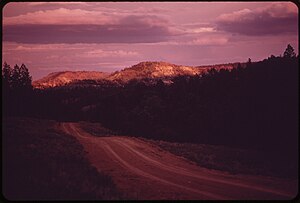Northern Cheyenne
|
Northern Cheyenne Indian Reservation Tsėhéstáno |
||
|---|---|---|
| Reservation | ||

Hills and Forests of the Northern Cheyenne Reservation
|
||
|
||
 Indian Reservations in Montana |
||
| Country | United States | |
| State | Montana, South Dakota | |
| Established | 1884 | |
| Government | ||
| • Governing Body | Tribal Council | |
| • Tribal President | Llevando Fisher | |
| Population (2013) | ||
| • Total | 4,939 | |
| Time zone | MST (UTC-7) | |
| • Summer (DST) | MDT (UTC-6) | |
The Northern Cheyenne Indian Reservation (Tsėhéstáno in Cheyenne, formerly named the Tongue River Indian Reservation) is home of the federally recognized Northern Cheyenne Tribe. Located in southeastern Montana, the reservation is approximately 444,000 acres in size and home to approximately 5,000 Cheyenne people. The tribal and government headquarters are in Lame Deer, which is also the home of the annual Northern Cheyenne Pow wow. The reservation is bounded on the east by the Tongue River and on the west by the Crow Reservation. There are small parcels of non-contiguous off-reservation trust lands in Meade County, South Dakota, northeast of the city of Sturgis. Its timbered ridges that extend into northwestern South Dakota are part of Custer National Forest and it is approximately 40 miles (64 km) east of the site of the 1876 Battle of the Greasy Grass (known to most Americans as the Battle of the Little Bighorn).
According to tribal enrollment figures as of March 2013, there are approximately 10,050 enrolled tribal members, of which about 4,939 reside on the reservation. Approximately 91% of the population were Native Americans (full or part blood quantum), with 72.8% identifying as Cheyenne. Slightly more than a quarter of the population five years or older spoke a language other than English. A few members of the Crow tribe also live on the reservation.
Traditional Cheyenne spiritual culture, like most traditional Indigenous spiritual ways, values the peoples' connection to their landbase, and sees the land itself, as well as special sites like Bear Butte, as sacred. Numerous Cheyenne work as foresters and fire fighters. This spiritual perspective is evident in traditional communities like Lame Deer and Birney and when the 2006 vote on development coal and coalbed methane on the reservation split along modernist vs traditional lines.
...
Wikipedia

